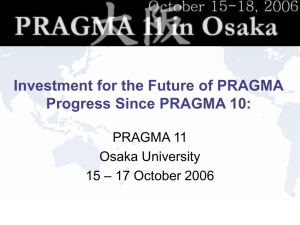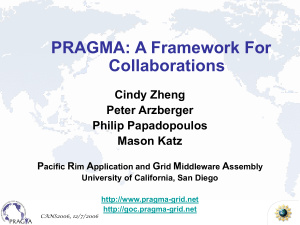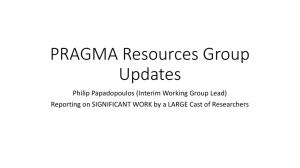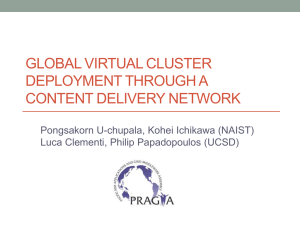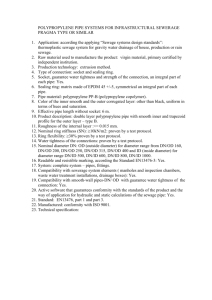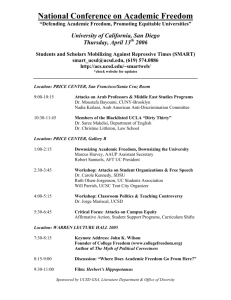ProgressSincePRAGMA20-ArzbergerPeter
advertisement
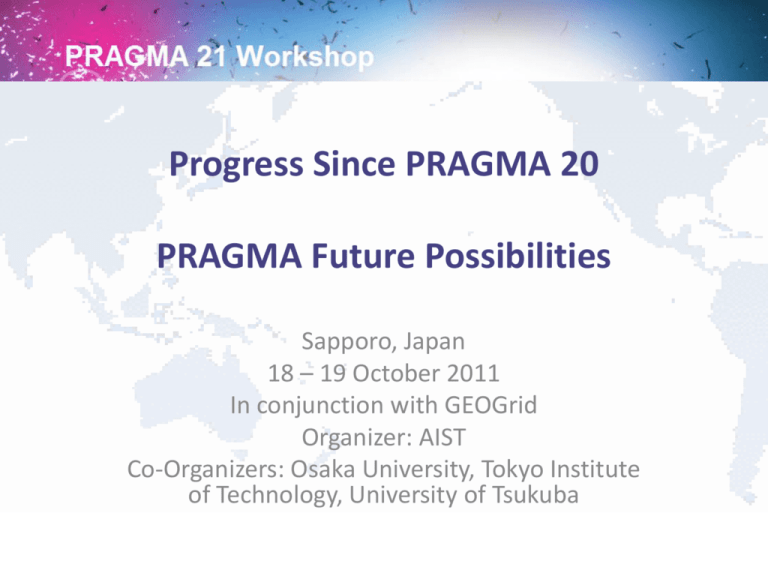
Progress Since PRAGMA 20 PRAGMA Future Possibilities Sapporo, Japan 18 – 19 October 2011 In conjunction with GEOGrid Organizer: AIST Co-Organizers: Osaka University, Tokyo Institute of Technology, University of Tsukuba Thank you for including PRAGMA PRAGMA 20 Unwavering Determination, Humility, and Commitment Highlights • VM Migration Experiment • Disaster Recovery of key services • Technology to engage public in cultural heritage • PRIME in 8th year producing results • MURPA in 4th year – expanding institutions • Stimulating other advances in members and partners VM Migration Experiment – Phase 2 From Grids to Clouds • A key demonstration – Building on progress since PRAGMA 20 (building from panel discussion at PRAGMA 17 in Hanoi) – The key is automation! – Use of PRAGMA member technologies (Gfarm) Phase 1: PRAGMA 20 • Future challenges – Data and computing – Interoperability • Core Participants: – AIST, NCHC, SDSC/UCSD • Additional Participants – IU, Osaka, LZU, UH Phase 2: PRAGMA 21 Disaster Recovery of Key Services • Massive earthquake and resulting tidal wave was devastating for Japan, AIST systems out of service – NCHC,SDSC/UCSD, other institutions in Japan, and U Chicago (R Grossman) assistant, migrate services • Key talk by Masashi Matsuoka! • Can PRAGMA members provide infrastructure to other members for this type of persistence of key services at a time of disruptions? Sharing and Preserving Cultural Heritage My Gallery Interactive • Multi-touch screen, allowing users to create their own gallery – Content from Museum of Photographic Arts San Diego (MoPA) – Built on technology developed by PRIME undergraduate in 2010 – Built by PRIME undergraduates in 2011, in collaborations with mentors • Shown in Knowledge Capital 2011 technology exhibition held in Osaka, Japan • Plans to deploy at MoPA in fall 2012 • Demo and poster • Participants: NICT, UCSD, MoPA PRIME – Developing Technologies • Integration of the Opal Web Service Client into the Duckling Portal – Resulted from PRAGMA 20 discussion – CNIC – Demo • Augmented Reality in Android System with a Disaster Response Application – Prototype of use of “every day” devices to integrate realtime data onto previous reality – NCHC • Navi: Covise-Kinert Navigation Interface with Cultural Heritage Application – NICT, Osaka PRIME – Imaging and Databases • Imaging in heart muscle – Auckland • Automatic image classification in wasps – TFRI • Database development on damage in NZ – Auckland PRIME – Bioscience Modeling • Modeling in cardiac myocytes – Monash University • Virtual screening, protein model building, influenza virus research – Osaka; CNIC, USM, NTU MURPA • Expanded Program in 2011 to NCSA – Will expand again in 2012 to Technion Locati Student on Mentor Title Sameer Cross Network Platform for Environmental Geoff Pascoe UCSD Tilak Sensor Data Capture and Analysis Integrating Web Services, Nimrod and Lin Wei UCSD Wilfred Li Kepler in Biomedical Workflows Jurgen James Wetter UCSD Schulze Real Time Visualisation in Astrophysics Wai Keung Yiu Ilkay Binding ITK with Kepler for Medical Man Lung UCSD Altintas Workflow Imaging Telematics in Music Collaboration, Edgar Kautzner NCSA Ben Smith Rehearsal and Performance Integration of Guard Parallel Software William Debugger into Blue Waters HPC Jian Zhang NCSA Gropp Environment Partner Updates • Korean Lake Ecological Observatory Network: – Developed a robust maintenancefree wireless communication service between water quality sensors in the fields and the KLEON data server, – Used DataTurbine • EDISON (EDucation-research Integration through Simulation On the Net) launched by KISTI – Build on e-Airs program – research and education for CFDs. PRAGMA’s First 10 Years Building a Family Demonstrable Results Highlights • Mobilized community to assist in response to SARS, and assist AIST with recovery of services • Contributed to launch of local / regional grids • Improved and helped disseminate software • With APGrid PMA promulgated security standards and practices • Supported conduct of science • Helped launch other grass-roots organizations • Created training and leadership programs Software of PRAGMA Members Software Ninf-G Gfarm Duckling CSF4 SCMSWeb e-AIRS Mgrid Nimrod Toolkit Institution AIST / NAREGI AIST and U Tsukuba CNIC Jilin U Kasetsart U KISTI Konkuk/Kookmin Monash MOGAS DataTurbine SAGE CADD Opal Toolkit INCA Rocks NTU - Singapore UCSD Calit2 EVL UIC NBCR UCSD NBCR UCSD SDSC UCSD SDSC PRAGMA Enhancement/Use Many applications Virtualization Tests Avian Flu Grid PRAGMA Workshops Avian Flu Grid GOC Tested on PRAGMA Grid Avian Flu Grid Savannah experiment; Volcanic Ash Distribution PRIME students Grid Operations Center PRIME, KEON, CREON/Thailand PRIME Avian Flu Grid Avian Flu Grid Grid Operations Center Virtualization Tests “Next year PRAGMA will be 10 years old. In these last ten years we have established deep and broad collaborations and friendships in the Asia Pacific region. We have also developed best practices in interoperations of grids, used the shared infrastructure to make scientific advances and improve software, leveraged the framework to help foster new grid efforts and new organizations, and established mechanisms to enhance the human capital and strengthen our collaborations.” – Yoshio Tanaka Model for Collaboration • “By actively participating in a large community such as PRAGMA, we can contribute our technology to real-world use in science.” Osaka, NICT • “Above all, PRAGMA brings great value to CCST in terms of broadening international collaboration, engaging applications, publishing scientific papers, and cultivating student.” • • • • • • Jilin University “There are always PRAGMA members working on interesting problems ready to push the boundaries of what we do.” Monash University “Learning from the PRAGMA collaboration, NCHC has built grid application platforms which have led to extensive involvement from NARL.” NCHC, NARL “Several of our own students have benefitted by interacting with [PRIME students]. This has helped us to evolve a very vibrant academic and research group here in our department ….” University of Hyderabad “PRAGMA led us to become a member of APGrid PMA, which became a significant component in our development of Thailand National e-Science Infrastructure Consortium. … to becom[ing] a part of GEO Grid collaboration .. . and helped with the setting up of a CREON site [at Racha Island]” NECTEC “PRAGMA has given Konkuk University opportunities for global collaboration with excellent research groups in the world and due to such opportunities, KU has become one of a leading institutes in interdisciplinary education and research in Korea.” Konkuk University “the exchange of ideas and culture that happened through out these years prepare our researchers to be ready to work in a new globalized world.” Kasetsart University PRAGMA in 2020 Defining Our Future Rethinking Our Structures and Processes Discussing Our Future • Panels – Strategies and future direction of PRAGMA – Networking and PRAGMA • Working Groups – What is your future? • Steering Committee – Talk with Steering Committee! – Synthesize input and strike balance • Goal is to engage all participants – namely YOU! Strategies and Future Direction of PRAGMA • • • • Fang-Pang Lin, NCHC, Telescience Kai Nan, CNIC, Resources Phil Papadopoulos, UCSD, Resources Yoshio Tanaka, AIST, Resources and GEO • Sornthep Vannarat, NECTEC, GEO “think deeply about the next 5 years and begin a process of constructing the ideas, framework, and proposals to reach into the future” Be Provocative and Constructive Networking and PRAGMA • • • • Maxine Brown (UIC) Tomohiro Kudoh (AIST) George McLaughlin (IU/TransPAC) Shinji Shimojo (Osaka U) What is the role of networking in our future? “how PRAGMA can collaborate with network communities and how PRAGMA will introduce the latest network technologies” Challenge to the Working Groups • Resources • GEO • Telescience • Biosciences • What are key challenges for the next five years that PRAGMA can uniquely address? – Who, What? • Does the current working group structure still make sense? – Overall area, current projects Framework for Discussion of Future • Developing, experimenting with, and exploiting new technologies • Addressing application areas important to the societal concerns of the region • Continuing to grow collaborations and people Does this framework capture the critical components for our success? What are PRAGMA’s unique contributions? Current and Future Challenges • People – Identify and engage (persistently) new researchers – Engage application scientists – Involve students • Products – Create products for each other, for the broader community • Innovation – Promote continual innovation • Obtain joint and coordinated funding – “The problems we face are global, but our funding is local.” – Can we work together with the funding agencies to address this challenge? Rest of the Program • Demonstrations – what is possible • Posters – time for discussions • Key note talks – stimulate thinking – Particular thanks to speakers and colleagues • Working Group discussions – what is practical • Steering Committee meeting – synthesize what has happened and where we are going Thanks to the Organizers and Committee Members • Program Committee – Yusuke Tanimura (AIST), Kohei Ichikawa (Osaka), Chao Jin (Monash) and Seok Jong Yu (KISTI) – Chih-Wen Chang (NCHC), Supakit Prueksaaroon (NECTEC) – Kevin Dong (CNIC), Rommie Amaro (UCI/UCSD) • Secretariat – Yuko Oshimia (AIST) Acknowledgements Organizers Sponsors • AIST • Osaka University • Tokyo Institute of Technology • University of Tsukuba • Ministry of Educaion, Sports, Culture, Science and Technology (MEXT) • DataDirect Network Inc • Appro International Inc • Argo Graphics • BioGrid Center Kansai • Cray Japan • KDDI R&D Labs Ince • NEC Corporation • SGI Japan • Beyond Computing Co.Ltd Thank You!
